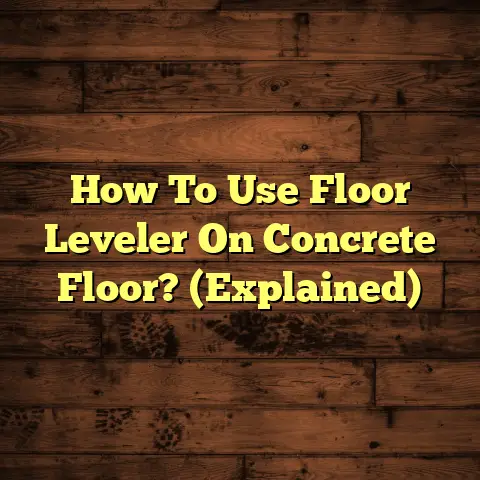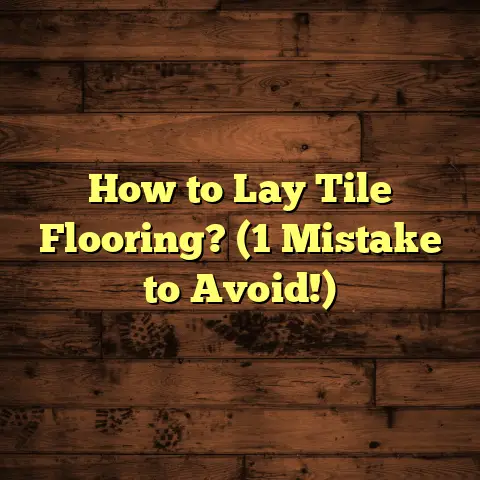Wood Stove Pads: Are Yours Safe? (4 Alarms!)
I’ve been in the flooring business for over 20 years, and I’ve seen firsthand the joy and comfort a good wood stove can bring.
There’s nothing quite like the crackling fire, the cozy warmth, and the feeling of self-sufficiency it provides.
But let’s be honest, a wood stove is only as good as its installation and maintenance.
And that’s where wood stove pads come in – they’re not just decorative; they’re absolutely essential for safety.
Think of wood stove pads as unsung heroes, quietly protecting your home from potential disaster.
They shield your floors from scorching heat, prevent accidental fires, and give you peace of mind knowing your family is safe.
In this article, I’m going to walk you through everything you need to know about wood stove pads.
We’ll cover what they are, why they’re important, how to evaluate their safety, and what to do if you spot any red flags.
Consider this your ultimate guide to wood stove pad safety! So, grab a cup of coffee (or hot cocoa!), and let’s dive in.
Understanding Wood Stove Pads
So, what exactly is a wood stove pad? Simply put, it’s a non-combustible barrier placed underneath and around your wood stove.
Its primary purpose is to protect your flooring and nearby walls from the intense heat radiated by the stove.
Think of it as a heat shield, deflecting heat and preventing it from reaching flammable materials like wood, carpet, or even certain types of tile.
Without a proper pad, you’re essentially playing with fire (literally!).
Now, there’s a variety of wood stove pads on the market, each with its own pros and cons.
Here’s a quick rundown of some of the most common types:
-
Concrete Pads: These are a classic choice, known for their durability and heat resistance. They’re often made from reinforced concrete, providing a solid, stable base for your stove.
-
Tile Pads: Tile pads offer a bit more aesthetic flexibility, as you can choose from a wide range of colors, patterns, and styles. However, it’s crucial to select tiles that are specifically rated for high heat applications.
-
Metal Pads: Metal pads are typically made from steel or aluminum and are often coated with a heat-resistant finish. They’re lightweight and easy to install, but they may not offer the same level of insulation as concrete or tile.
-
Specialty Pads: There are also a number of specialty pads available, made from materials like stone, brick, or even recycled rubber. These pads often offer unique aesthetic appeal and varying levels of heat resistance.
But how do these pads actually work? Well, it’s all about heat transfer.
The pad acts as a buffer, absorbing the heat from the stove and dissipating it over a larger surface area.
This prevents the heat from concentrating in one spot and potentially igniting the flooring below.
The materials used in these pads are specifically chosen for their ability to resist heat and prevent combustion.
Think about it, wood stoves haven’t always been around.
Early versions were much more basic, and the concept of a dedicated “pad” wasn’t always a priority.
Over time, as homes became more insulated and fire safety awareness grew, the need for effective heat protection became clear.
That’s when wood stove pads started to evolve, incorporating new materials and designs to meet increasingly stringent safety standards.
Safety Standards and Regulations
Alright, let’s talk about the boring but essential stuff: safety standards and regulations.
I know, I know, it’s not the most exciting topic, but trust me, understanding these guidelines can save you a lot of headaches (and potential disasters) down the road.
Several organizations set the standards for wood stove pads.
Two of the most important are Underwriters Laboratories (UL) and the National Fire Protection Association (NFPA).
UL, for example, conducts rigorous testing on wood stove pads to ensure they meet specific safety requirements.
These tests evaluate things like heat resistance, fire retardancy, and structural integrity.
If a pad passes these tests, it receives a UL listing, which is a sign that it’s been independently verified to meet safety standards.
The NFPA, on the other hand, develops codes and standards related to fire safety.
NFPA 211, for instance, covers the installation of chimneys, fireplaces, vents, and solid fuel-burning appliances (like wood stoves).
This standard provides detailed guidelines on the type of pad required, its size, and its placement in relation to the stove and surrounding combustible materials.
But here’s the thing: national standards are just the starting point.
You also need to be aware of local building codes and regulations.
These codes can vary from city to city and county to county, so it’s crucial to check with your local building department to ensure you’re in compliance.
They’ll be able to tell you exactly what’s required in your area, including any specific permits or inspections you may need.
What happens if you don’t comply with these regulations? Well, the consequences can be pretty severe.
First and foremost, you’re putting your home and family at risk of fire.
A non-compliant pad may not provide adequate protection, leading to overheating, ignition of nearby materials, and potentially a full-blown house fire.
Secondly, you could face legal repercussions.
If a fire occurs due to a non-compliant installation, your insurance company may deny your claim, leaving you on the hook for costly repairs and damages.
You could also be subject to fines or other penalties from your local building department.
I’ve seen it happen, and trust me, it’s not pretty.
So, do yourself a favor and take the time to understand the safety standards and regulations in your area.
It’s a small price to pay for peace of mind and the safety of your loved ones.
Evaluating the Safety of Your Wood Stove Pad
Okay, you’ve got a wood stove pad in place. Great! But is it really safe?
Don’t just assume everything’s fine. It’s time to put on your inspector hat and give your pad a thorough once-over.
Here’s a step-by-step guide to help you evaluate the safety of your existing wood stove pad:
Step 1: Material and Thickness
First, take a close look at the material your pad is made of. Is it concrete, tile, metal, or something else?
Make sure the material is non-combustible and specifically designed for use with wood stoves.
Next, check the thickness of the pad. The required thickness will vary depending on the type of stove and the type of flooring you have.
But as a general rule, thicker is better when it comes to heat resistance.
Step 2: Distance to Combustibles
This is a big one. Measure the distance between your wood stove and any nearby combustible materials, such as walls, furniture, curtains, or even wood trim.
NFPA 211 specifies minimum clearance distances for different types of stoves and installations.
Make sure you meet or exceed these minimums. If you’re unsure, err on the side of caution and increase the distance.
Step 3: Overall Condition
Carefully inspect the pad for any signs of wear and damage.
Look for cracks, chips, discoloration, warping, or any other abnormalities.
These could indicate that the pad is deteriorating and no longer providing adequate protection.
Pay close attention to areas that are directly exposed to the heat of the stove, as these are most likely to show signs of damage.
So, what are some common signs that your wood stove pad might not be safe? Here are a few red flags to watch out for:
-
Cracking: Cracks can weaken the structural integrity of the pad and allow heat to penetrate through to the flooring below.
-
Discoloration: Discoloration, especially scorching or charring, indicates that the pad is being exposed to excessive heat and may be losing its protective properties.
-
Warping: Warping suggests that the pad is not able to withstand the heat and is deforming under pressure.
-
Loose or Missing Tiles: If you have a tile pad, check for loose or missing tiles. These can create gaps in the protective barrier and allow heat to reach the flooring.
-
Rust or Corrosion: On metal pads, look for signs of rust or corrosion. This can weaken the metal and reduce its ability to dissipate heat.
Now, let’s talk about those “4 alarms” I mentioned earlier. These are specific indicators that signal potential safety issues with your wood stove pad.
The 4 Alarms of Wood Stove Pad Safety
Alright, let’s get down to the nitty-gritty.
These four alarms are your early warning system, helping you identify potential problems before they turn into major safety hazards.
Alarm 1: Overheating
Overheating is a sign that your wood stove pad isn’t doing its job effectively. But how do you know if your pad is overheating?
Well, there are a few telltale signs to watch out for:
-
Excessive Heat Radiating from the Pad: If you can feel a significant amount of heat radiating from the pad, even when you’re standing several feet away, it’s a sign that the pad is not properly dissipating the heat.
-
Discoloration or Scorching: As mentioned earlier, discoloration or scorching on the pad is a clear indication that it’s being exposed to excessive heat.
-
Burning Odors: If you smell a burning odor coming from the area around the wood stove, it could be a sign that the pad is overheating and potentially igniting nearby materials.
-
Floor Damage: Check the flooring around the pad for any signs of heat damage, such as discoloration, warping, or cracking.
If you notice any of these signs, it’s crucial to take action immediately.
First, reduce the amount of wood you’re burning in the stove.
Overfiring the stove can generate excessive heat and overwhelm the pad’s ability to dissipate it.
Second, ensure that the stove is properly ventilated and that the chimney is clean and free of obstructions.
A blocked chimney can cause the stove to overheat and increase the risk of a chimney fire.
Finally, consider adding additional insulation to the pad or replacing it with a thicker, more heat-resistant option.
Alarm 2: Inadequate Coverage
Size matters! Your wood stove pad needs to be large enough to protect the surrounding area from sparks, embers, and radiant heat.
The specific size requirements will vary depending on the type of stove and local building codes.
But as a general rule, the pad should extend at least 16 inches in front of the stove door and 8 inches to the sides and rear.
Why is adequate coverage so important? Well, think about what happens when you open the stove door to add more wood.
Sparks and embers can easily escape and land on the floor.
If the pad is too small, these embers could ignite the flooring or nearby rugs, leading to a fire.
Similarly, radiant heat from the stove can travel several feet, potentially damaging walls, furniture, or other combustible materials.
An adequately sized pad will act as a barrier, preventing these hazards from occurring.
To determine if your pad is providing adequate coverage, measure the distance from the stove to the edge of the pad in all directions.
Compare these measurements to the minimum requirements specified in NFPA 211 or your local building codes.
If your pad is too small, you’ll need to replace it with a larger one.
You may also need to adjust the placement of the stove to ensure that it’s properly centered on the pad.
Alarm 3: Material Degradation
Even the best wood stove pads will eventually degrade over time, especially if they’re exposed to high heat and frequent use.
It’s crucial to regularly inspect your pad for signs of material degradation, such as:
-
Cracking: Cracks can weaken the structural integrity of the pad and allow heat to penetrate through to the flooring below.
-
Spalling: Spalling is the flaking or crumbling of the pad’s surface. This is often caused by repeated exposure to heat and moisture.
-
Discoloration: As mentioned earlier, discoloration or scorching indicates that the pad is being exposed to excessive heat and may be losing its protective properties.
-
Warping: Warping suggests that the pad is not able to withstand the heat and is deforming under pressure.
-
Rust or Corrosion: On metal pads, look for signs of rust or corrosion. This can weaken the metal and reduce its ability to dissipate heat.
If you notice any of these signs, it’s time to replace your wood stove pad.
Don’t wait until the damage gets worse, as this could increase the risk of a fire.
When choosing a replacement pad, be sure to select one that is specifically designed for use with wood stoves and that meets all applicable safety standards.
Alarm 4: Improper Installation
Even the best wood stove pad won’t protect you if it’s not installed correctly.
Improper installation can create gaps in the protective barrier, allowing heat to reach the flooring or walls.
Here are some common installation mistakes to watch out for:
-
Uneven Surface: The pad should be placed on a level surface. If the surface is uneven, the pad may not make full contact with the flooring, creating gaps where heat can escape.
-
Gaps Between Pad and Flooring: There should be no gaps between the pad and the flooring. These gaps can allow sparks and embers to fall through, potentially igniting the flooring below.
-
Incorrect Pad Placement: The pad should be placed in the correct location, according to the manufacturer’s instructions and local building codes.
-
Failure to Use Proper Fasteners: If the pad requires fasteners, such as screws or anchors, be sure to use the correct type and size.
To rectify improper installation, start by ensuring that the surface is level and clean.
Use shims or other leveling materials to create a flat, even surface.
Next, carefully position the pad in the correct location, making sure that it’s centered under the stove and that it meets all clearance requirements.
Finally, secure the pad to the flooring using the appropriate fasteners.
If you’re not comfortable with any of these steps, it’s best to hire a qualified professional to install the pad for you.
Best Practices for Maintaining Wood Stove Pads
Okay, you’ve got a safe and properly installed wood stove pad. Now what?
Well, like any other component of your home, your wood stove pad requires regular maintenance to ensure it remains safe and effective over time.
Here are some best practices to follow:
-
Regular Inspections: Make it a habit to inspect your wood stove pad at least once a month, especially during the heating season. Look for any signs of wear, damage, or material degradation, such as cracks, chips, discoloration, or warping.
-
Cleaning Routines: Keep your wood stove pad clean and free of debris. Use a broom or vacuum cleaner to remove any ash, dust, or dirt that may accumulate on the pad. Avoid using harsh chemicals or abrasive cleaners, as these can damage the pad’s surface.
-
Seasonal Checks: In addition to regular inspections, perform a more thorough check of your wood stove pad at the beginning and end of each heating season. This is a good time to inspect the pad for any signs of damage that may have occurred over the past year.
-
Chimney Sweeping: Have your chimney professionally swept at least once a year. A clean chimney will help your stove burn more efficiently and reduce the risk of a chimney fire.
-
Professional Inspections: Consider having your entire wood stove system, including the pad, professionally inspected every few years. A qualified technician can identify potential problems that you may have missed and recommend appropriate repairs or upgrades.
Conclusion
Alright, we’ve covered a lot of ground in this article.
We’ve talked about what wood stove pads are, why they’re important, how to evaluate their safety, and what to do if you spot any red flags.
I hope you’ve found this information helpful and that you now have a better understanding of how to keep your home safe while enjoying the warmth and comfort of a wood stove.
Remember, a wood stove is a wonderful addition to any home.
When properly maintained and installed, it can provide efficient, cost-effective heating and create a cozy, inviting atmosphere.
But it’s crucial to prioritize safety and take the necessary steps to protect your home and family from potential fire hazards.
So, take action today! Assess your wood stove pad, address any issues you find, and make sure you’re following best practices for maintenance and safety.
By doing so, you can enjoy all the benefits of a wood stove without compromising your peace of mind.
Stay warm and stay safe, my friends!





